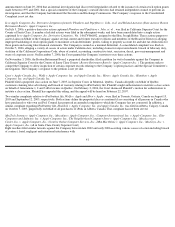Apple 2006 Annual Report Download - page 39
Download and view the complete annual report
Please find page 39 of the 2006 Apple annual report below. You can navigate through the pages in the report by either clicking on the pages listed below, or by using the keyword search tool below to find specific information within the annual report.
the United States District Court for the Northern District of California, also alleging that the iPod infringed the ‘433 patent. The District Court
action was stayed pending resolution of the Creative ITC Action.
On May 15, 2006, the Company brought suit against Creative in the United States District Court for the Western District of Wisconsin
(“Wisconsin Action”), alleging that Creative infringed U.S. patent number 5,479,602 (“‘602 patent”), U.S. patent number 5,586,237 (“‘237
patent”), U.S. patent number 5,898,434 (“‘434 patent”), and U.S. patent number 6,731,312 (“‘312 patent”). On May 17, 2006, the Company
filed an amended complaint in the Wisconsin Action alleging that Creative also infringed U.S. patent number 5,341,293 (“‘293 patent”), U.S.
patent number 6,047,342 (“‘342 patent”), and U.S. patent number 5,799,280 (“‘280 patent”).
On June 1, 2006, the Company brought suit against Creative in the United States District Court for the Eastern District of Texas, (“Texas
Action”), alleging that Creative infringed U.S. patent number 6,157,363 (“‘363 patent”), U.S. patent number 5,640,566 (“‘566 patent”), and
U.S. patent number 5,504,852 (“‘852 patent”). On June 27, 2006, the Company filed an amended complaint in the Texas Action alleging that
Creative also infringed U.S. patent number 7,046,230 (“‘230 patent”) and U.S. patent number 6,282,646 (“‘646 patent”). At the suggestion of
the District Court, the Company filed separate actions in the Eastern District of Texas regarding the Company’s allegations relating to the ‘230
patent and the ‘646 patent.
On June 1, 2006, the Company filed a complaint with the ITC alleging that Creative infringed the ‘230 patent, the ‘293 patent, and the ‘434
patent. On June 5, 2006, the Company filed an amended complaint with the ITC alleging that Creative also infringed the ‘646 patent.
The parties reached a settlement of all of the above matters and all cases were dismissed as of October 13, 2006. These matters are concluded.
Settlement of these matters did not have a material effect on the Company’s financial position or results of operations.
Davis v. Apple Computer, Inc.
Plaintiff filed this purported class action in San Francisco County Superior Court on December 5, 2002, alleging that the Company engaged in
unfair and deceptive business practices relating to its AppleCare Extended Service and Warranty Plan. Plaintiff asserts causes of action for
violation of California Business & Professions Code §17200 (unfair competition), California Business & Professions Code §17500 (false
advertising), breach of the Song-Beverly Warranty Act, intentional misrepresentation and concealment. Plaintiff requests unspecified damages
and other relief. The Company filed a demurrer and motion to strike, which were granted, in part, and Plaintiff filed an amended complaint.
The Company filed an answer on April 17, 2003 denying all allegations and asserting numerous affirmative defenses. Plaintiff subsequently
amended his complaint. On October 29, 2003, the Company filed a motion to disqualify Plaintiff’s counsel in his role as counsel to the
purported class and to the general public. The Court granted the motion but allowed Plaintiff to retain substitute counsel. Plaintiff did engage
new counsel for the general public, but not for the class. The Company moved to disqualify Plaintiff’s new counsel and to have the Court
dismiss the general public claims for equitable relief. The Court declined to disqualify Plaintiff’s new counsel or to dismiss the equitable
claims, but did confirm that the class action claims were dismissed. The Company appealed the ruling and the case was stayed pending the
outcome of the appeal. The Court of Appeals denied the appeal on August 17, 2005, affirming the trial court’s decision. The Company filed a
Petition for review with the California Supreme Court, which was denied on November 23, 2005. The case was remanded back to the trial
court. The parties have reached a settlement and the matter is concluded. Settlement of this matter did not have a material effect on the
Company’s financial position or results of operations.
38
























